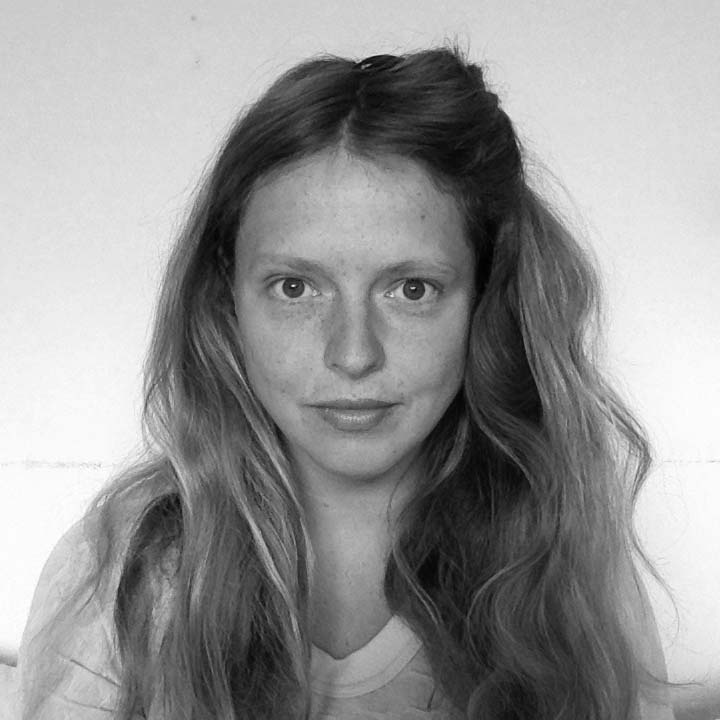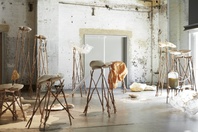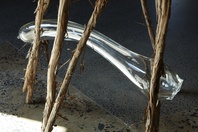Isadora Vaughan
Wurundjeri/Boon Wurrung Country, Narrm (Melbourne)
2021
Displayed 2021 at Carriageworks

Isadora Vaughan
Born 1987, Wurundjeri/Boon Wurrung Country, Narrm (Melbourne). Lives and works on Wurundjeri/Boon Wurrung Country, Narrm (Melbourne)
Isadora Vaughan is a Melbourne-based visual artist whose sculptural works are characterised by the tension between materiality and form. Vaughan’s work oscillates somewhere between the formal and the alchemical, employing a process of speculative questioning that draws from geology, craftsmanship and science. Interested in the ability of materials to transform from one state to another, she creates ephemeral and static sculptural installations that engage with the sensory capabilities of the body.
Artist text
by Amanda Saker
In general, by employing various methods, water has a potent healing ability. One can, therefore, say of most ordinary substances, that a poisonous substance can also become a medicine. Consequently, one must recognize how such an element works, including the effect it has on the human constitution. (1)
Organs of Cognition manifests as a kind of laboratory – both investigative and generative. Liquids amass, disperse, solidify, dissipate, opacify, leak and muddy, entering into a somewhat digestive dialogue. As Isadora Vaughan notes, at times it is ‘more like a piece of spent machinery so full of fat, it no longer moves’. (2) It’s exactly this material accrual and level of production the artist is interested in, ‘the relic or residue of the things left behind’. On a macro level, Vaughan probes ideas around permaculture and material intelligence; more intimately she considers our relationship with the non-human world and the sculptural encounter.
Melaleuca alternifolia branches, used by First Nations people for healing and medicinal purposes, sprout under and over chalky ceramic forms cradling beeswax, beef gelatin, oil and other visceral material. Sculptural forms escort fluids like intestinal instruments both played and playing, receptive to our bodies in space; curious glassy pipes lay lodged between their woody limbs as if caught in the wind. Thorny clay puddles heat and cool, licked by the sunlight that exposes their delicate depths. Extending a latent emotional resonance, intestinal shells soften, slump, contract and crack; no material more sexy or gross than the other.
From the fragility of the paperbark and pig’s collagen, to the dimpling and dissipating earthly matter, a soft material flux hints at transformation but also a burning out – of the individual and social body to that of the planet. The relationship between Vaughan’s forms (circulating, filtering and catching) speaks to the chaotic intellect of the natural world and indeed our imaginations, if only we let them in.
As a departure point, Vaughan alludes to the symbolic Flowform design. Popularised in the 1970s as a domestic fountain for its positive effects on mood and energy and more widely applied in biodynamic agriculture, the form creates an efficient rhythmic biomimicry (a figure eight) to invigorate and ‘purify’ water based on the ‘The Vortex Principle’ introduced by Austrian philosopher, educator and artist Rudolf Steiner. The principle observed that ‘a stream, bubbling merrily over the stones, forms countless inner surfaces and tiny vortices, which are all sense organs, open to the cosmos’, (3) sitting comfortably within an aesthetic language familiar to the artist (Vaughan attended a Steiner School), but also within our collective consciousness as a symbol of biomimicry.
Disinterested in ‘creating a vessel that in some godly way, purifies something that’s no longer evident’, the work exists in a constant state of becoming; resistant to imitation and generative of new ways of being. ‘It’s kind of a physical manifestation of this idea about the relationship between the celestial or the larger than this planet imagination,’ she says, articulating this sense of continued transferral, from anthroposophy to permaculture and industrial design histories, to the gallery space.
Like Steinerian thinking, Organs of Cognition opposes a subject-object/spirit-matter view of the world, proposing knowledge as an active process of interaction with the phenomenal world. (4) We find ourselves part of a narrative less concerned with purification or biodynamics and more interested in our bodies as collaborative producers, manifestations of all things that flow.
(1) Rudolf Steiner, Über Gesundheit und Krankheit (On Health and Illness), lecture series, Dornach, 13 Jan 1923, p.250, translated by Nesta Carsten-Krüger, at wordpress.com/tag/healing/, accessed 1 Feb 2021.
(2) All quotes from the artist are from a conversation with the author, 3 Feb 2021.
(3) Theodor Schwenk, Sensitive Chaos, Rudolf Steiner Press, London, 1965, p.67.
(4) Steiner’s views in Philosophy of Freedom (1894) and other works, at natureinstitute.org/about/rudolf-steiner, accessed 10 Feb 2021.
Artist's acknowledgements
Isadora Vaughan is represented by STATION, Melbourne and Sydney.


